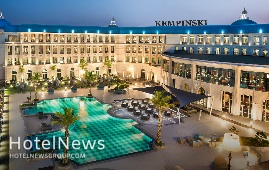
Reports indicate a rise in travel expenses and a greater emphasis on environmental issues among Emirati and Saudi travellers. According to these reports, travellers are now significantly incorporating sustainability considerations into their travel plans and are willing to pay over 20 percent extra for stays in eco-friendly accommodations. Furthermore, artificial intelligence technology is increasingly becoming a key tool for travel planning, more accessible to Emirati and Saudi travellers.
Create: Mar 8, 2024 Edit: Mar 8, 2024 International News
A new report from the World Travel and Tourism Council and Microsoft predicts the transformative power of artificial intelligence in the tourism and travel industry, promising an unparalleled experience for customers. This report redefines travel and tourism standards and calls for greater integration of these technologies into the industry.According to the report, tourism and travel businesses are encouraged to prioritize artificial intelligence as a strategic priority and make significant investments in fostering collaboration between humans and artificial intelligence. The World Travel and Tourism Council believes that artificial intelligence can play a pivotal role in providing personalized and advanced experiences for travelers both now and in the future.By analyzing traveler data, optimizing pricing strategies through real-time adjustments, and providing instant responses and precise interactions through advanced chatbots, this technology can enhance personalized recommendations and marketing strategies.
Create: Feb 28, 2024 Edit: Feb 28, 2024 International News
With a forecast of significant growth, the outbound travel market of the Gulf Cooperation Council (GCC) countries is expected to reach $57.5 billion by 2028. This increase is primarily due to rapid growth in outbound tourism in the United Arab Emirates and Saudi Arabia, indicating an increasing inclination of people in this region to travel abroad. Moreover, Generation Z is recognized as the vanguards of this growth. This generation increasingly utilizes the "Bleisure" trend, a combination of business and leisure, to create a balance between their personal and professional lives.
Create: Feb 28, 2024 Edit: Feb 28, 2024 International News
In 2024, Qatar will transform into a global focal point by hosting 80 significant cultural, sports, and scientific events.Organized by the Qatar Tourism Authority, these events provide a unique opportunity for visitors from around the world to experience Qatar's cultural diversity, creativity, and innovation. The comprehensive calendar for the year 2024 in Qatar, recently released by the Qatar Tourism Authority, encompasses a wide spectrum of events in various fields.Hosting these events provides Qatar with an unparalleled opportunity to emerge as a global tourist destination and showcase its cultural diversity, creativity, and innovation to the world)
Create: Feb 28, 2024 Edit: Feb 28, 2024 International News
The Global Hotel Alliance (GHA), the world's largest alliance of independent hotel brands with 40 hotel brands, has announced a new record in 2023.Celebrating its twentieth anniversary, the alliance witnessed a 20% increase in Gross Operating Revenue (GDR) compared to 2022. Additionally, the number of reservations surged by 30%, with a 25% increase in member hotels. GHA also expanded into 10 new markets in 2023. This success is attributed to various factors including GHA's focus on innovation and technology, providing unique services and benefits to member hotels, and establishing a strong network of independent hotels worldwide.
Create: Feb 23, 2024 Edit: Feb 23, 2024 International News
Turkish airlines , a global leader in aviation, has hailed a major move made by Türkiye to extend visa-free entry to the nationals of the UAE, Oman, Bahrain, and Saudi Arabia Tourists from these countries can now spend 90 out of 180 days in Türkiye without a vi The new visa exemption rule is set to bolster ties between Türkiye and these countries, and further strengthen the country’s tourist numbers from 2024, Turkish Airlines noted
Create: Feb 23, 2024 Edit: Feb 23, 2024 International News
Radisson Hotel Group completed 2023 with extraordinary growth, adding more than 30,000 rooms to its international portfolio of 10 leading brands with new openings and agreements. With these results, Radisson Hotel Group has grown its operations by 50% since 2018, when the transformation plan began. In 2023, Radisson Hotel Group broke a new record with the agreements and openings of more than 30,000 rooms added to its portfolio. Radisson Blu, the group's leading brand, continued to be Europe's largest upper segment brand for the 12th time in a row. Head of Global Development, Radisson Hotel Group, said: We are grateful to our friends. We expect 2024 to be a continuation of 2023 as inflation slows down and investors' interest in the sector continues.
Create: Jan 25, 2024 Edit: Jan 25, 2024 International News
Hotels that we look forward to their exciting opening in 2022 Part 3; Nobu Santorini Hotel- Greece 🇬🇷 The 26th branch of Nobu Hotel in Greece will be opened in Santorini Nubo hotel architect Designed in the traditional whitewashed Cycladic style with minimalistic décor to optimally enhance the dramatic vistas beyond. Nobu Hotel Santorini offers 25 stunning accommodations, all with breathtaking views of the Caldera and the Aegean Sea. It offer a nobu restaurant, luxe spa, fitness center, two level infinity pool and five pool villas Nobu hotel opening this spring is also just 20 minutes from santorini international airport. It also offers a unique blend of Japanese hospitality and stunning Santorini and Whether you’re looking for Nobu Hotel classics or locally packages, explore our offers to find the stay that suits you best.
Create: Oct 22, 2022 Edit: Oct 22, 2022 TV
Wyndham Hotels & Resorts, the world’s largest hotel franchising company with approximately 9,000 hotels across nearly 95 countries, continues to expand its global footprint with its entry into Poland with the 205-room upscale Wyndham Wroclaw Old Town. Managed by Mogotel Hotel Group, a leading hotel operator in the Baltics, the property is expected to open early next month and will be located in the heart of Wroclaw’s city center. One of the largest cities in Western Poland and home to many renowned universities and research centers, Wroclaw combines rich history and charming architecture with a lively cultural scene across its museums, theatres, art galleries and workshops. Perfectly positioned for exploring the central, picturesque Old Town with many attractions and landmarks, the hotel will feature stylish guest rooms, an expansive atrium and a top floor wellness area, with a state of the art fitness room, sauna and steam bath. The hotel will offer a wide range of food and beverage outlets including a gourmet restaurant, a cozy lounge and bar to relax and socialize. Those traveling for business will also have access the hotel’s 11 meeting rooms, which accommodate a total capacity of over 400 attendees. In addition, the hotel is conveniently located just 10 miles from Wroclaw’s International Copernicus Airport. Wyndham Wroclaw Old Town is the latest addition in Wyndham Hotels & Resorts growing portfolio in Europe, including over 350 operational hotels across 30 countries and a development pipeline of over 90 properties. Wyndham hotels in Poland and around the world participate in Wyndham Rewards, the world’s most generous hotel rewards program with more than 50,000 hotels, vacation club resorts and vacation rentals worldwide.
Create: Jan 11, 2022 Edit: Jan 11, 2022 International News
Iran pavilion is set to add extra charm to the prestigious Expo 2020 Dubai by widening its outline such as an enormous celebration of Noruz, the Persian New Year, which will begin on March 21. The decision was reached during a meeting between the Cultural Heritage, Tourism and Handicrafts Minister Ezatollah Zarghami, Culture and Islamic Guidance Minister Mohammad-Mehdi Esmaeili and Industry, Mining, and Trade Minister Reza Fatemi Amin, Mehr reported on Sunday. During the meeting, the financial support needed to implement the ideas for improving the condition of Iran’s pavilion during the remaining 100 days of the expo was also discussed. Noruz, which usually falls on March 21st every year, marks the beginning of spring across a vast geographical area. The feast was initially registered on the UNESCO List of the Intangible Cultural Heritage of Humanity in 2009, as a common tradition for Iran, Azerbaijan, India, Kyrgyzstan, Pakistan, Turkey, and Uzbekistan. However, the five other countries put in requests officially to be added to the list during a meeting held in Tehran in January 2014. In December 2016, Iran and 11 other countries registered Noruz as a common tradition during the 11th session of the Intergovernmental Committee for the Safeguarding of the Intangible Cultural Heritage, held in Addis Ababa, Ethiopia. Noruz, according to UNESCO, promotes the values of peace and solidarity between generations and within families, as well as reconciliation and neighborliness, thus contributing to cultural diversity and friendship among peoples and various communities. Noruz traditions, however, vary from place to place, ranging from leaping over fires and streams in Iran to tightrope walking, lighting candles at house doors, traditional games such as horse racing, or the traditional wrestling practiced in Kyrgyzstan.
Create: Jan 3, 2022 Edit: Jan 3, 2022 Regional News
Menus are an important aspect of the overall presentation of a hotel restaurant. Indeed, a whole book on proper menu design could be written, with inventory arrangements, fonts, graphics, spacing, types of paper, menu backings and all other stylistic concerns outlined as contributing factors for a guest’s overall appreciation of the dining outlet. The pandemic has thrown a wrench in this marketing and sentiment-boosting tool as many customers now expect menus to be accessible on their phones via a QR code. The benefit for the restaurant is certainly there in the form of saving on printing costs, but it’s nonetheless a tradeoff. The concern that we have over the proliferation of QR menus is that they don’t build guest satisfaction as much as their physical antecedents, and this reduced sentiment can halo back onto room revenues in a negative way. Here’s why: paper is palpable. You feel the slight roughness of a thick paper stock, subtly smell the ink, are delighted by the way the room’s lighting creates soft shadows on the page and are soothed by (what we ideally hope that you would use for your establishment) the touch of the leather menu backing on the palm of your hand. Viewing a menu on your phone gives you none of that. Yes, you get graphics, color and the ability to keep the webpage updated in real-time as inventory changes, but everything beyond the straight visuals are lost in the endless scroll of a two-dimensional screen. And building on this notion of scrolling, one critical difference is that a physical menu presents all items together for readers to consider, whereas a responsive webpage (over simply displaying a PDF version of the menu) will usually configure all items into a single column so as to keep everything legible and to avoid lots of pinching. This second drawback is one of perception, where a narrowly focused column on one’s phone can increase the observed length of the menu, resulting in patrons ‘dropping off’ before perusing the entirety of it. We see a similar trend in website readership where it falls precipitously after around the first quarter of an article or page. In sum, on digital-first menus, you have to put your most expensive items (or highest margin) items at the top or they will likely be missed. At this point, with the end of the pandemic still very much a question mark, optionality and fitting your theme is what works best. Paper menus should be readily presented at high-end restaurants so that the theme is congruent and customer satisfaction isn’t deteriorated, while at more casual settings a QR code access may be just fine. While there are both paper and labor costs associated with QR menus, you must still consider the above downsides.
Create: Jan 1, 2022 Edit: Jan 1, 2022 F and B
After years marred by a global public health crisis, many of us are lapping up in-person social gatherings with friends, family and colleagues. Morning catch-ups over coffee, afterwork happy hour at the favorite waterhole or weekend drinks in town had mostly been replaced with coffees-to-go, virtual apéros, or alfresco drinking in winter like in summer. Consumers have become today their own baristas and bartenders, imbibing alone at home or at a distance outside. So how, and with what, will we quench our thirst? Here is EHL’s selection of the top drink trends in 2022. In this pandemic-era, there is no doubt that the megatrends for the new year will center around healthier and ‘cleaner’, more sustainable, premium and socially responsible products in line with the mantras – good for me, good for the planet – and quality over quantity. With movements like mindful drinking and “sober curious” gaining popularity, research indicates that alcohol consumption has declined with younger generations drinking less as they show greater interest in holistic wellness and health. And the beverage industry has been paying attention to these shifts in concern, consciousness and habits. Functional and healthy beverages are on the rise, and no and low alcohol ready-to-drink offerings from North America to Europe and Asia-Pacific have boomed as they prove to be both a more convenient and ‘safer’ option in a world still plagued by COVID-19 measures and barrier gestures. But globally, we’re seeing an array of interesting new product developments, packaging innovations and surprising mergers and acquisitions with the lines between the health movement, the low- and no- alcoholic category and the wider drinks industry becoming increasingly blurred. Beyond these general tendencies, we take a look at six particular drink trends for the year ahead. 1. CBD-infused relaxation drinks For those of us who frequent trendy bars, a controversial yet very 2022 new trend has found its way onto cocktail menus in only the most avant-garde of venues. 2. The bubble tea craze goes global Despite being invented in the 1980s, bubble tea is set to see its popularity soar to new heights. From the US to Germany, China to Brazil, the bubble tea industry is going global with its market expected to grow by almost $2 billion to reach $4.3 billion by 2027. The refreshing Taiwanese tea-based drink with its tapioca or fruit jelly ‘bubbles’ is appealing to health-conscious individuals enjoying the healthier variants low in sugar, with organic soya milk, green tea or fruity mixes as well as a younger generation seduced by its 200 or so different flavor combinations and even more customizable options making for a truly unique, tasty and fun drink. 3. Fermented drinks as a health-booster Increased awareness on the importance of fueling our body with quality and nutritious food and drink is driving a rapid growth in fermented beverages, occupying a significant portion within the functional and healthy drinks category. It’s estimated that probiotic beverages are expected to achieve over $77 billion in sales by 2025, almost double the revenue generated worldwide in 2018. While kombucha has been topping the leader board for some years, it’s now got some serious competition. Water kefir, with its more diverse probiotic strains shown to help boost the immune system and aid digestion, is gaining momentum and creeping into the mainstream. As is the fermented Mexican soda Tepache – another healthy, flavorsome, sustainable alternative to kombucha. While not new in itself, it has promising prospects in this ‘health-conscious’ era, but hey, it’s just a gut feeling! 4. Wines and champagnes with star power Celebrity beverage endorsements are nothing new. Think George Clooney and Nespresso, Jennifer Aniston and Smart Water, or countless sporting stars endorsing energy drinks. But expect to see more and more vineyards and champagne houses partnering with big names to capitalize on their glamorous images and extend their respective brand portfolios. After John Legend, Kylie Minogue or Brad Pitt, Cameron Diaz is the latest celebrity to venture into the wine business with her “clean” wines. The range comprises of an organic and vegan French rosé and Spanish white with no added sugar, with Diaz tapping into both the wellness trend and that of the growing ‘thirst’ for ‘pink’ wine. Such partnerships are also strategic in helping introduce wines and champagnes to new consumers, in particular millennial drinkers drawn to celebrity and wellness lifestyles, and who aren’t impartial to the Instagrammable aesthetic of a fizzy or rose-tinted drink. 5. Boxed wine as a sustainable (and sanitary) choice Did you know that during the COVID-19 pandemic, bag-in-a-box wine was the supermarket alcoholic “go-to” beverage? The draw? Beyond the product within the bag, boxed wine is easier to store, it better preserves open wine, and is proving a more hygienic and sustainable option, in particular for restaurants. With each three-liter box generating about half the carbon dioxide emissions to that of a glass bottle, boxed wine is also cheaper to transport, stock and more environmentally-friendly. Something that even the more premium wine houses can’t ignore. While wine connoisseurs may jump to the conclusion that boxed wine equates to poor quality, industry experts are suggesting that that’s changing, and fast, as sales are forecast to continue surging around the world in 2022. 6. Canned cocktails with premium products While some may have enjoyed following online mixology tutorials to create their own home-made cocktails, many long for the days when original creations were served ready-made for immediate consumption. Well, spirit brands and hotel chains like the Marriott have wasted no time to offer the perfect solution and create a variety of delicious, bartender-quality, ready-to-drink cocktails in cans. Tipped to be the hottest trend in the alcoholic beverage space in 2021, the development of prepared cocktails-to-go has, according to Nielsen Premium Panel data, accelerated 171% in 2020, and shows no signs of slowing down in 2022. With high-quality ingredients, authentic flavors, options between low-calorie, sugar and alcohol or premium spirits, and convenient and sanitary packaging – grab-and-go cocktails are here to stay. 7. Spiked sodas and alcohol-free beers and spirits With interest in low and no alcohol by volume (ABV) drinks skyrocketing over the last few years, more and more people are looking for a middle ground between tee-total and drinker, between functional and indulgent, between high-quality and convenience. Consequently, low and non-alcoholic beverages are flooding the market and is the space to watch. From non-alcoholic beers and premium mocktails by spirit brands to the boom of hard seltzers now spilling over into hard coffees and kombucha – consumers are going to be spoilt for choice. Whether it’s wanting something with less sugar and alcohol, with premium products, looking for a slight ‘kick’ in traditional non-alcoholic beverages or an alternative to beer, this growing category ensures there’s something for every taste bud and type of drinker. Drink trends 2022: a toast to good health As we look to turn our backs on 2021, and raise our glasses to a new year, the question still lingers as to whether the drinking habits developed in a COVID-era will prevail in a post-pandemic world. While there is still so much uncertainty, what is clear is that the increasing consumer interest in health, wellness and mindfulness is shaping the beverage industry as a whole as it seeks to quench this thirst for holistic balance. For being able to choose alcohol-free beverages without having to sacrifice flavors, fizz or authenticity. For indulging in a drink without having to abstain completely. For a return to more simplicity with natural and ‘clean’ products. For drinking less in quantity but better in quality.
Create: Jan 1, 2022 Edit: Jan 1, 2022 Coffee Shop
